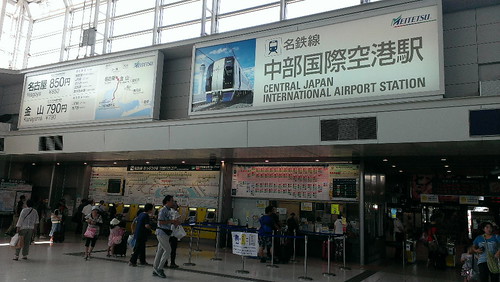
Because of the journey to South America in January, some destinations in my pocket are not so suitable for my budget.
However, I still want to travel no matter where the detination is.
Under such consideration, I choose to visit Japan for the second time and focus my trip around the Chūbu region.
Compared with other countries, the arrangement for Japan travel is different in some ways.
For example, the railway is the recommended option for the main transportation, and the backpacker accommodations are not so common in Japan. Something like these will be the important issues you will think of.
If you want to visit someplace at where the hotel is the only choice, travelling alone will be embarrassed for booking the accommodation.
These details are gained from my first trip to Hokkaido five years ago, and these are quite helpful for arranging the Japan travel this time.
On the departure day, our plane is delayed for almost two hours due to the machanical misfunction, and therefore we arrive at Central Japan International Airport in the late afternoon.
I know that someone might prefer to have a busy schedule, but you will never know what will happen out of your expectation.
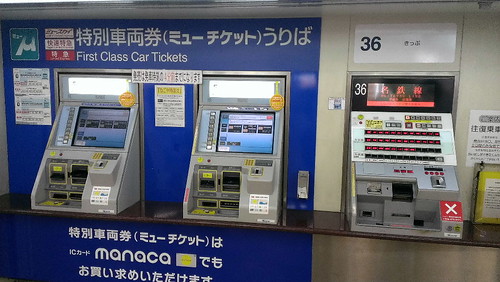
From airport to Naogoya, Meitetsu Train should be a good one.
But I have to sya that the ticket system in Japan is a little complex for Taiwan tourists, for we always get one ticket no matter which transportation we choose.
Meitetsu Train has many types of trains that are different for the speeds and the stations they stop, such as ミュースカイ (μSKY Limited Express), 特急(Limited Express), 快速急行(Rapid Express), 急行 (Express), 準急(Semi Express), and 普通(Local).
μSKY Limited Express is the fastest one but all cars are reserved (shown as 全車特別車), and therefore, you need to buy the common train tickets and additional "特別車両券ミューチケット" (First Class Car Ticket, μticket)
Limited Express is the second fastest one but some cars are ordinary cars (shown as 一部特別車). You could get on these ordinary cars only with the common train ticket, but still have to get a μticket if you want to stay in the first class car.
As for the rest, these trains only have ordinary cars and you only have to buy the common train ticket.
That is the way, the ticket system most Japanese railways adopt. The common railway tickets is the transportation fare for all types of trains and the additional ticket, such as μticket or others, is the surcharge for the faster train or the reserved seat.
In Taiwan, our railway ticket is always one with different fare according to the train type. I think that is much simpler.
Anyway, we buy the railway ticket for 850 Yen and get on the train to Nagoya.
Somone might wonder what they should do if they get on the μSKY Limited Express without μtickets. If the cars still have empty seats, you could buy μtickets from the trainman. If the cars are full-reserved, it would be embarrassed and you might have to stand all the way.

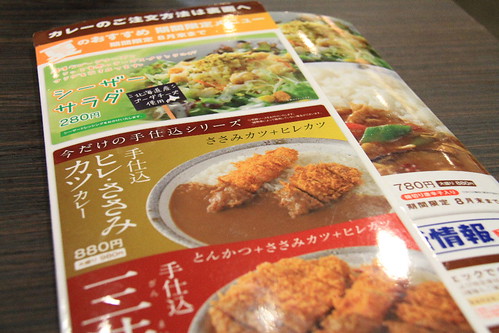
Arriving at Nagoya station, my first thing is to buy the JR tickets that the time is specific in my schedule.
Though Chūbu region may be not so popular as Kantō region (Tokyo) or Kansai region (Kyoto, Osaka), I think it would be safe to buy the tickets in advance. Besides, you could pay on your credit card.
By the way, I don't bring my big luggage case and only carry my 32L backpack and camera bag.
Some items that must be put in the check-in luggage are stored in my mother's medium-size luggage case.
In Japan, the majoy sizes of the coin lockers are small and medium. Big lockers are few.
Therefore, if you don't want to drag your luggages to the hotel before you start your daily trip, it would be a good idea not to bring the big luggage.
Sometimes, you may move from one city to another and may visit the attractions in the middle. At this moment, you have to find the suitable coin locker for your luggage. This is the problem you might encounter if you arrange your trip this way.
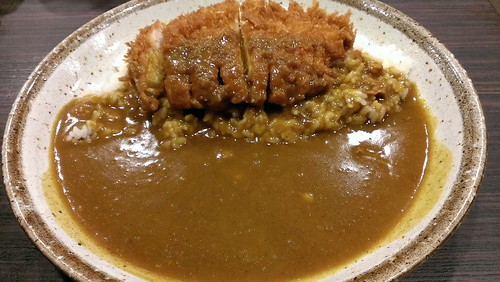
Our hotel, Toyoko INN, is near Nagoya station and the street before the hotel is full of restaurants where you could drink wine or beer and eat Japanese barbecue or other dishes.
After putting down my luggage, I go to the curry house "CoCo壱番屋" for my late dinner.
This curry house also operates in Taiwan.
You could choose the size of the rice, the side dishes (fried pork, shrimps and etc), the type of the curry source and the degree of how spicy you want.
The price is also proper in average. I think you should try Japanese curry for at least one time. It's delicious.
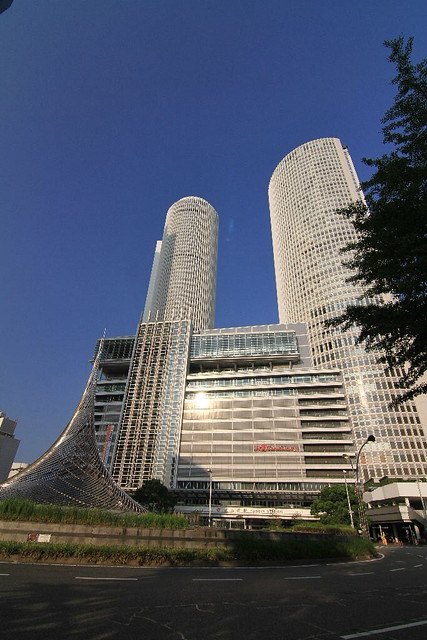
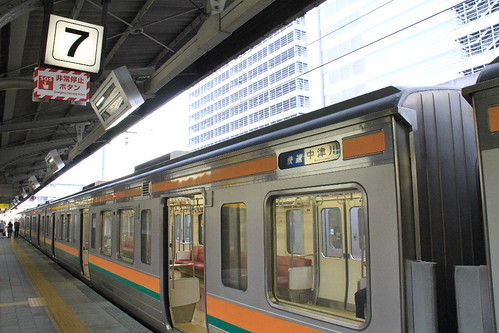
In the morning tomorrow, we start our first visiting with the JR local train to Nakatsugawa (中津川).
The itinerary today is simple. We will take the bus from Nakatsugawa to Magome, and then walk from Magome juku (馬籠宿) to Tsumago juku (妻龍宿). Finally, we will take another bus to Nagiso (南木曽) JR station and take the JR train back to Nagoya.
If you travel with children or elders, simple is an important issue in your schedule.
Of course, I think it's still too tiring to walk from Magome to Tsumago if your kids are still too small.
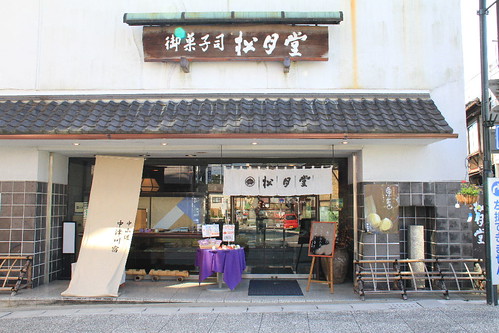

Because we still have time before the first bus to Magome, I go for the local specialties according to the information I searched in advance.
The first shop is "松月堂" (Access Map) that they sell many Japanese dessert made of chestnut, such as the Matcha-flavored chestnut roll cake.
Someone may think that the Japanese dessert is too sweet but it's actually suitable while you accompany with Japanese green tea, Matcha.
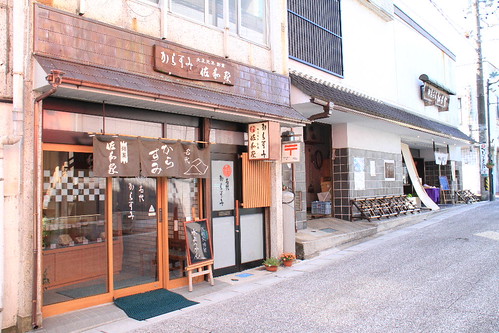
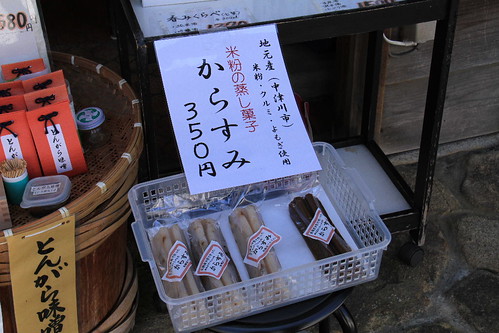
Another shop "からすみ 佐和家" is just next to 松月堂.
Karasumi (からすみ) is the specialty only found in Gifu region, such as Nakatsugawa and Magome.
I found this specialty introduced on the TV program "日本大國民" in Taiwan.
In fact, Karasumi is not a dessert for most of the Japanese except Gifu region. It's actually the mullet roe.
However, in Gifu region, Karasumi means the dessert made of rice.
Why they give this dessert such a confusing name?
It's said that the Gifu region is far from the sea and the Gifu people could not get delicious seafood easily.
In order to pray for children that they could grow up healthily, they made the dessert with rice that is similiar to Karasumi in shape.
As the time went by, Karasumi for Gifu people is not a seafood anymore, and the Gifu people will prepare Karasumi in the Girl's Day every year (桃の節句, 雛祭り, Hinamatsuri)

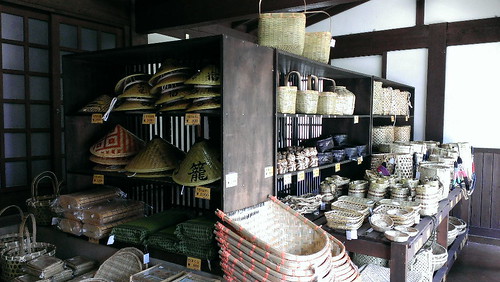
We take ths bus at 9:40 to Magome and it takes about 23 minutes to arrive there.
Magome was one of the stations of the Nakasendō which was an ancient road from Kyoto to Edo in Edo period.
It's a place where travelers, especially officer, could rest during the journey, just like the rest stops along the highway in Taiwan or Japan.
Though it was hard to recieve profit but they got helped in the forms of various permits, rice collection and simple money lending.
Nowadays, this old route with its appearance as an Edo period post town becomes a famous tourist attractions.
Walking from Magome to Tsumago is along an easy-walking mountain route that you could also enjoy the nature in the countryside.
In Taiwan, we also have old routes like Nakasendō, such as Caoling Historic Trail from Taipei to Yilan.
However, Caoling Historic Trail is short of facilities such as toilets, vending machines or shops.
Though Jiufen is another famous old town in Taipei that is similiar to the post town , it was an isolated village for the gold mine and is too crowded nowadays.
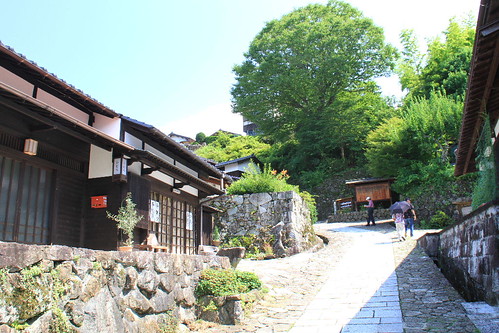
Walking slowly along the stone path, we find that there are already many tourists here. Magome is indeed a famous attraction.
Except for the Shimazaki Tōson museum and some private houses, the houses along the route are mostly specialty shops, gift shops and restaurants.
I also find Karasumi that is produced in Nakatsugawa.
The main street in Magome is not too long and then the scenery changes into the standard countryside with green mountains, limited roads and few houses.
There is an observatory nearby where you could enjoy such a nice scene and then walk towards Tsumago.


The route after Magome is still simple and you will get across the vehicle roads several times.
Something that surprises me is the Bear Alarm located on the route.
It seems that the brown bears appear in this area for sure.
I hope that I'm not such a lucky tourist who meet brown bears here.
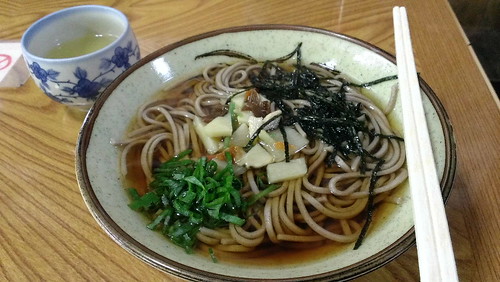
Around the noon, we reach the top of this mountain route, "馬籠峠".
It also means that the rest will be very easy.
A small rest stop is nearby and we have the noodle soups as the lunch.
Due to the foreign tourists, the Japanese elder boss could speak a little English.

Passing the top and walking down the descent for a certain distance, we find another bigger rest stop, "立場茶屋".
"立場茶屋" (Tateba tea house) is the rest stop established by local people for travelers that could be traced back to the Edo period.
It was the extended facility of local people's house.
Except for drinking tea, they also provide refreshments.
Because we have had the lunch, we just pass this tea house without resting again.
By the way, although Nakasendō is a mountain route, its altitude is not high and the weather is hot in the daytime. So, never forget your hat or umbrella.
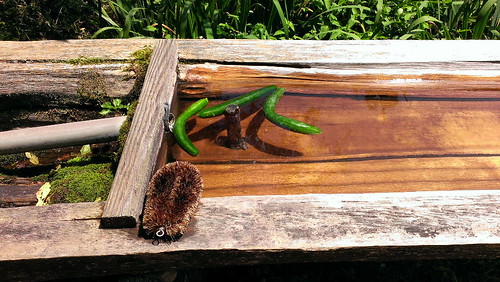

Fortunately, most of the route is in the forest that is much comfortable in such a hot weather.
You may find the Ksitigarbha's statues or the stile carved with Buddhism words along the way.
I think these statues and stiles have special atmosphere while lighted up by the sunshine.
Maybe they could protect travelers from meeting brown bears.
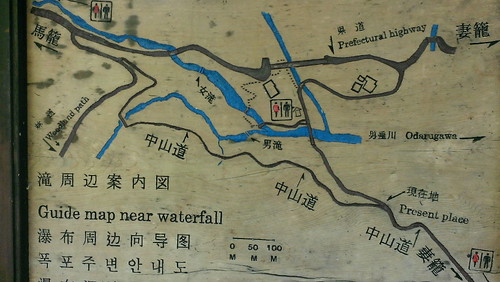

Before reaching the Tsumago region, there are two waterfalls called Men's Waterfall and Women's Waterfall.
These waterfall are not high and huge as those I saw in Iceland, but it's a nice place to rest if you need water to cool down.

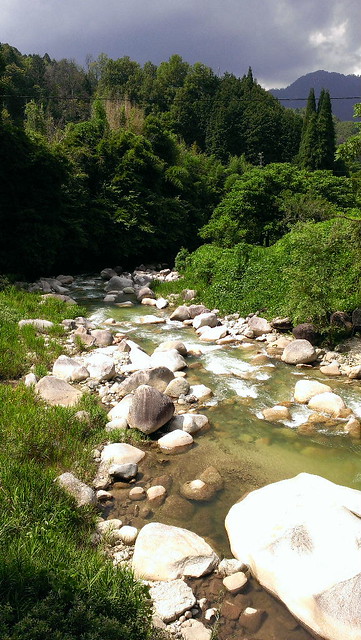
While getting close to Tsumago, the houses appear again.
Though the Japanese style houses or the straw horse are special, I prefer the pure river.
The river is so clear that you will believe the water is drinkable.
In Taiwan, most of the rivers are polluted and we don't trust the water anymore.
I really think that Taiwan should learn from Japan to protect or to restore the treasurable nature for a better life.
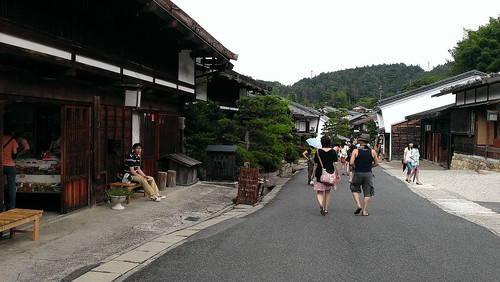

Around 3 o'clock, we finally arrive Tsumago.
The outer region is not so crowded with some Japanese hotels.
Generally speaking, I think the scene of Magome is better than tsumago.
Maybe that is because the paved road is not so old-style as the stone path.
The shops in center Tsumago are also a lot and so are the tourists.
Even it's already late afternoon, many tourist coaches still arrive here one after one.
Most of these tourists are taking a day trip provided by the travel angency.
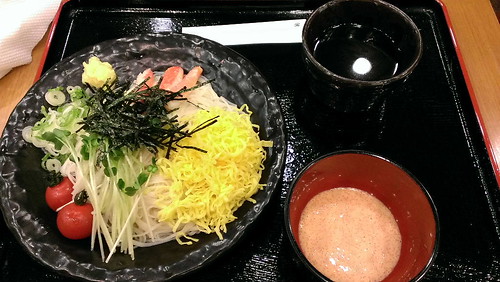

After the brief visiting in Tsumago, we wait for the bus to Nagiso station.
Someone may prefer taking bus between Magome and Tsumago instead of walking, but I recommend walking from Magome to Tsumago (or from Tsumago to Magome) so that you will not miss the natural scenery along the way.
Taking the JR train back to Nagoya, we have the dinner at the 13th floor of the department store of Nagoya JR station.
"山本屋總本家" (yamamotoya) is the recommended restaurant by many backpackers.
Because my mon doesn't like the strong-seasoned dishes, she choose the sōmen (そうめん).
The salad source with shrimp eggs is marvelously delicious.
As for me, I choose the Miso Nikomi Udon (味噌煮込うどん) that the udon is stewed in miso source.
The udon is a little harder than other udon I have eaten and the miso source is really thick.
However, this kind of dish is the specialty here. So, try it once at least.
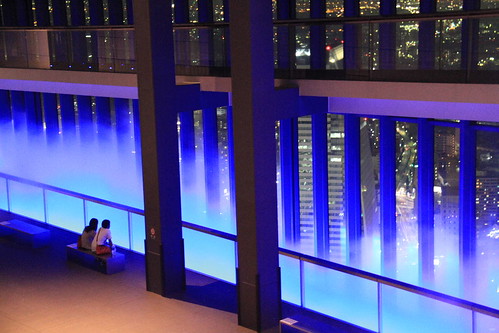


In the night, I go to the 42th floor of "Midland Square" that is the building opposite to the Nagoya JR station.
The Sky Promenade at the 42th floor is a famous place for the night scence of Nagoya city.
Besides, there is also a restaurant and the water feature with lights is also another special point.
However, I think the night view of Nagoya is not so great as the world-famous night view seen from Mount Hakodate in Hakodate, Hokkaido.
The altitute of the viewing place and the scheme of the city are the two important factor of the night view.
Therefore, the night view of Nagoya is normal to me, except for the Nagoya castle lighted up in the night.
In addition, I think the glass windows is certainly the bad thing while taking photos of the night view.
So, I don't have any expectation here and didn't bring my tripod with me.
Maybe a high mountain nearby the city would be a better choice but I don't have any idea of it.
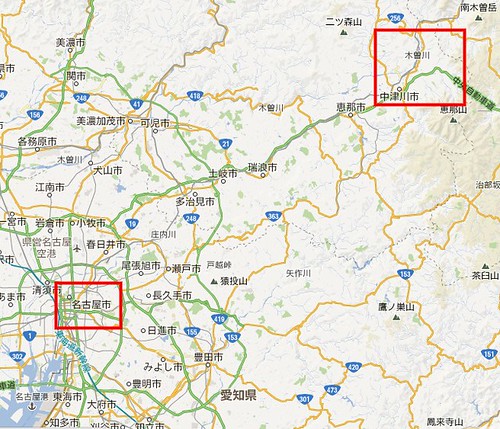

References:
http://en.wikipedia.org/wiki/List_of_regions_of_Japan
http://www.meitetsu.co.jp/english/
http://en.wikipedia.org/wiki/Matcha
http://en.wikipedia.org/wiki/Karasumi
http://www.enasan-net.ne.jp/esn/050111/
http://gifu-omiyage.sakura.ne.jp/karasumi.html
http://en.wikipedia.org/wiki/Hinamatsuri
http://en.wikipedia.org/wiki/Magome-juku
http://en.wikipedia.org/wiki/Shukuba
http://en.wikipedia.org/wiki/Tsumago-juku
http://www.taiwanderful.net/guides/caoling-historic-trail
http://en.wikipedia.org/wiki/Jiufen
http://www.nakasendoway.com/?page_id=1376
http://en.wikipedia.org/wiki/Ksitigarbha
http://en.wikipedia.org/wiki/S%C5%8Dmen
http://recipes.wikia.com/wiki/Miso_Nikomi_Udon
http://wikitravel.org/en/Japan's_Top_3
http://en.wikipedia.org/wiki/Nagoya
http://en.wikipedia.org/wiki/JR_Central_Towers
http://www.travel-around-japan.com/index.html


 留言列表
留言列表
